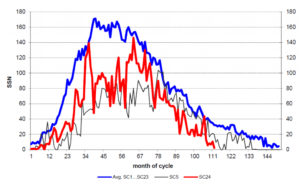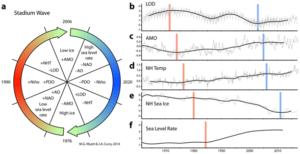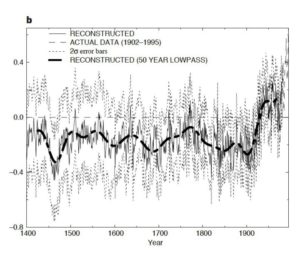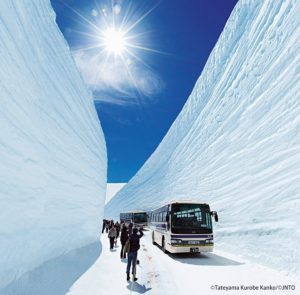by Open Mind, April 29, 2018
Lately I’ve been looking closely at sea level time series from the east coast of the U.S. Available stations are marked here with red dots (…)
by Open Mind, April 29, 2018
Lately I’ve been looking closely at sea level time series from the east coast of the U.S. Available stations are marked here with red dots (…)
by F. Bosse and Prof. F. Vahrenholt, April 28, 2018 in NoTricksZone
As the current solar cycle nears an end, it will go down as the weakest in close to 200 years. And as inhabitants of the northern hemisphere dig themselves out of an especially icy and snowy winter and Arctic sea ice rebounds, it may all be in part linked to low solar activity as many scientific studies have long suggested.

Figure 1: The current solar cycle no. 24 (red) compared to the mean of the previous 23 recorded solar cycles (blue) and the similar solar cycle no. 5 (black)
(…)
by Henri Fountain, April 26, 2018 in TheNewYorkTimes
IBRA, Oman — In the arid vastness of this corner of the Arabian Peninsula, out where goats and the occasional camel roam, rocks form the backdrop practically every way you look.
But the stark outcrops and craggy ridges are more than just scenery. Some of these rocks are hard at work, naturally reacting with carbon dioxide from the atmosphere and turning it into stone.
Veins of white carbonate minerals run through slabs of dark rock like fat marbling a steak. Carbonate surrounds pebbles and cobbles, turning ordinary gravel into natural mosaics.
Even pooled spring water that has bubbled up through the rocks reacts with CO2 to produce an ice-like crust of carbonate that, if broken, re-forms within days.
Scientists say that if this natural process, called carbon mineralization, could be harnessed, accelerated and applied inexpensively on a huge scale — admittedly some very big “ifs” — it could help fight climate change. Rocks could remove some of the billions of tons of heat-trapping carbon dioxide that humans have pumped into the air since the beginning of the Industrial Age.
And by turning that CO2 into stone (…)
by University of California – Irvine, April 26, 2018 in ScienceDaily
By taking a closer look, scientists find resilience in face of heat stress.
Coral reef bleaching is stark evidence of the damage being inflicted by global climate change on marine ecosystems, but a research team has found some cause for hope. While many corals are dying, others are showing resilience to increased sea surface temperatures, pointing to possible clues to the survival and recovery of these vitally important aquatic habitats (…)
See aslo here
by Eric Worrall, April 26, 2018 in WUWT
Maldives Environment Minister Thoriq Ibrahim has warned that unless the Maldives gets its climate cash before 2020, the 1.5C global warming limit will be breached.
Read more: http://www.climatechangenews.com/2018/04/26/paris-agreement-starts-2020-will-late/
This call for climate cash echoes a similar demand from African nations a few weeks ago.
I’m not sure how the Maldives reconciles their climate concerns with all their fly-in tourism and their aggressive airport and resort building programmes, but no doubt some of that climate cash will help with the reconciliation if it ever arrives.
by Javier, April 26, 2018 in WUWT
It is a well-known feature of climate change that since 1850 multiple climate datasets present a ~ 60-year oscillation. I recently wrote about it in the 7th chapter of my Nature Unbound series. This oscillation is present in the Atlantic Multidecadal Oscillation (AMO), Arctic Oscillation (AO), North Atlantic Oscillation (NAO), Pacific Decadal Oscillation (PDO), Length of Day (LOD), and Global (GST) and Northern Hemisphere (NHT) temperatures, with different lags.

To me this oscillation is not a cycle because prior to 1850 it had a more variable period and it is not well identified in LIA records. Since the origin of this oscillation is unknown, models have a hard time reproducing it and it is all but ignored by the IPCC. It is a big oscillation with an amplitude of ± 0.3 °C in NHT (0.1-0.2°C in GST; figure 2). While the long-term temperature trend is unaffected by it, there is a large effect on the 30-year trends. If this oscillation is considered, most of the climate alarmism vaporizes.
(…)
by Ph.D. Roy W. Spencer, Apritl 24, 2018 in Global Warming
Global warming “problem” cut by 50%
As readers here are aware, I don’t usually critique published climate papers unless they are especially important to the climate debate. Too many papers are either not that important, or not that convincing to me.
The holy grail of the climate debate is equilibrium climate sensitivity (ECS): just how much warming (and thus associated climate change) will occur in response to an eventual doubling of the CO2 concentration in the atmosphere?
Yesterday’s early online release of a new paper by Nicholas Lewis and Judith Curry (“The impact of recent forcing and ocean heat uptake data on estimates of climate sensitivity“, Journal of Climate) represents one of those seminal papers.
by Anthony Watts, April 25, 2018 in WUWT
Beijing has undergone several important urbanization development stages since late 1978. Linked with urbanization, the so-called “urban heat island effect” is a key problem caused by urban land expansion. Such changes in air temperature in Beijing inevitably have an impact on the daily lives of its inhabitants, and is therefore of considerable interest to scientists and the wider public alike.
Dr. Xiaojuan LIU and Associate Professor Guangjin TIAN from the School of Environment, Beijing Normal University, used the mesoscale Weather Research and Forecasting model coupled with a single urban canopy model and high-resolution land cover data to analyze the spatial and temporal patterns of summertime urban warming influenced by three stages of urban land expansion during 1990-2010 across Beijing. They found that urban-induced warming increased with urban land expansion, but the speed of warming declined slightly during 2000-10.
by ‘hockeschtick‘, November 27, 2014
A paper published today in Journal of Atmospheric and Solar-Terrestrial Physics finds a “strong and stable correlation” between the millennial variations in sunspots and the temperature in Antarctica over the past 11,000 years. In stark contrast, the authors find no strong or stable correlation between temperature and CO2 over that same period.
We have thus shown
- Strong correlation between solar activity and climate over the past 11,000 years of the Holocene
- Strong lack of correlation between CO2 and climate over the past 11,000 years of the Holocene
- Solar activity explains all 6 well-known warming periods that have occurred during the Holocene, including the current warm period
- The 20th century peak in sunspot activity is associated with a 40 year lag in the peak global temperature
by J. Curry and N. Lewis, April 24, 2018 in ClimateAudit
There has been considerable scientific investigation of the magnitude of the warming of Earth’s climate by changes in atmospheric carbon dioxide (CO2) concentration. Two standard metrics summarize the sensitivity of global surface temperature to an externally imposed radiative forcing. Equilibrium climate sensitivity (ECS) represents the equilibrium change in surface temperature to a doubling of atmospheric CO2 concentration. Transient climate response (TCR), a shorter-term measure over 70 years, represents warming at the time CO2 concentration has doubled when it is increased by 1% a year.
(…)
See also here
by Anthony Watts, April 23, 2018 in WUWT
Twenty years ago today: The infamous “hockey stick” graph that crystalized global warming and ignited the climate wars was published, and became known as MBH98. The science in it was so bad, it is credited with spawning the modern climate skeptic movement.

Original “hockey stick” temperature graph in Nature, 1998. The Y axis shows the Northern hemisphere mean temperature, in degrees Celsius; the zero line corresponds to the 1902 – 1980 mean. Credit: “Global-scale Temperature Patterns and Climate Forcing over the Past Six Centuries,” by Michael E. Mann et al. in Nature, Vol. 392, April 23, 1998
by Polar Bear Science, April 21, 2018
New evidence from clams and mussels with temperature-sensitive habitat requirements confirm that warmer temperatures and less sea ice than today existed during the early Holocene period about 10.2–9.2 thousand years ago and between 8.2 and 6.0 thousand years ago (based on radio carbon dates) around Svalbard. Barents Sea polar bears almost certainly survived those previous low-ice periods, as they are doing today, by staying close to the Franz Josef Land Archipelago in the eastern half of the region where sea ice is more persistent (…)
See also CBC.news
by A. Stewart, April 23, 2018 in ClimateChangeDispatch
Could someone explain in 100 words or less without complex algebraic formulas how the trace gases, approximately 1% of the atmosphere can overtly control the temperatures of the remaining 99% atmospheric constituents?
by Donna Laframboise, April 23, 2018 in ClimateChangeDispatch
SPOTLIGHT: After the Intergovernmental Panel on Climate Change (IPCC) report was released in 2007, its dramatic findings of species extinction were repeatedly emphasized by chairman Rajendra Pachauri.
BIG PICTURE: When it examined the question of species extinction, the 2007 IPCC report relied heavily on a single piece of research – a Nature cover storypublished early in 2004. Written by Chris Thomas and 18 others, this was the source of Pachauri’s claim that climate change threatened 20 to 30% of the world’s species.
by Anthony Watts, April 22, 2018 in WUWT
You think we had a bad winter here in the USA? Look at Japan where they have walls of snow 56 feet tall (almost the height of a 6-story building).
There’s an avalanche of tourists coming to the Tateyama to see the walls of snow.

It has been a rough winter full of snow all over the northern hemisphere, as this newest NOAA-20 satellite image shows
(…)
by Anthony Watts, April 22, 2018 in WUWT
In the May 2000 issue of Reason Magazine, award-winning science correspondent Ronald Bailey wrote an excellent article titled “Earth Day, Then and Now” to provide some historical perspective on the 30th anniversary of Earth Day. In that article, Bailey noted that around the time of the first Earth Day in 1970, and in the years following, there was a “torrent of apocalyptic predictions” and many of those predictions were featured in his Reason article. Well, it’s now the 48th anniversary of Earth Day, and a good time to ask the question again that Bailey asked 18 years ago: How accurate were the predictions made around the time of the first Earth Day in 1970? The answer: “The prophets of doom were not simply wrong, but spectacularly wrong,” according to Bailey.
Here are 18 examples of the spectacularly wrong predictions made around 1970 when the “green holy day” (aka Earth Day) started
(…)
by K. Richard, April 19, 2018 in NoTricksZone
The Arctic region was the largest contributor to the positive slope in global temperatures in recent decades.
Consequently, the anomalously rapid warming in the Arctic region (that occurred prior to 2005) has been weighted more heavily in recent adjustments to instrumental temperature data (Cowtan and Way, 2013; Karl et al., 2015) so as to erase the 1998-2015 hiatus and instead produce a warming trend.
Meanwhile, other scientists have been busy determining that only about 50% of the warming and sea ice losses for the Arctic region are anthropogenic, or connected to the rise in CO2 concentrations.
The rest of the warming and ice declines can be attributed to unforced natural variability.
by Tony Heller, April 20, 2018 in TheDeplorableClimSciBlog
The first half of April was third coldest in the past 110 years in the US, and the coldest since 1975. The three warmest first fifteen days of April occurred in 1910, 1930 and 1925, when about 80% of days were over 60 degrees.
by P. Gosselin, April 20, 2018 in NoTricksZone
I’ve been regularly bringing you climate and energy news from Germany, with Kenneth in USA posting on the latest science.
Now NoTricksZone is happy to report we are also working with skeptic Japanese climate blogger Kirye, who runs KiryeNet. This means we’ll also be occasionally presenting skeptic news out of Japan in English.
For example in last Tuesday’s post Kirye delivered the key parts on the Arctic Freezamageddon. Our aim is to provide more of such posts in the future.
Views from other countries like Japan are always extremely useful. There really isn’t any global climate science consensus. It’s fraudulent to claim that there is.
by Mark Fife, April 19, 2018 in WUWT
In today’s post I am going to go over how I went about creating a reconstruction of the history of temperature from the GHCN data sets using a variable number of stations reporting each year for the years of 1900 to 2011. Before I go into the details of that reconstruction, let me cover how I went about discarding some alternative methods.
I decided to create a test case for reconstruction methods by picking five random, complete station records. I then deleted a portion of one of those records. I mimicked actual record conditions within the GHCN data so my testing would be realistic. In different trials I deleted all but the last 20 years, all but the first 20 years or some number of years in the middle. I tried normalizing each station to its own average and averaging the anomalies. I tried averaging the four complete stations, then normalizing the fourth station by its average distance from the main average. In all cases when I plotted the reconstruction against the true average the errors were quite large.normalizing the fourth station by its average distance from the main average. In all cases when I plotted the reconstruction against the true average the errors were quite large.
by Garth Paltridge, April 18, 2018 in ClimateEtc.
An essay on the state of climate change science.
(1) Is the science of climate change ‘settled’?
The scientific uncertainties associated with climate prediction are the basis of most of the arguments about the significance of climate change(25), and as well are the basis of much of the polarized public opinion on the political aspects of the matter. Perhaps the most fundamental of the uncertainties can be illustrated by reference to a simple ‘thought experiment’ as follows.
(…)
(2), (3), (4)
by P. Homewood, April 17, 2018 in NotaLotofPeopleKnowThat
I was at the Mall last weekend, and came across this local anti fracking group holding some sort of a workshop.
One wonders if they realise where the energy they use every day comes from?
(…)
by Uzbek, 2 avril 2018 in ClimatoRéalistes
La Global Warming Policy Foundation (GWPF) a publié son rapport sur l’état du climat pour 2017. Etabli par Ole Humlum, Professeur émérite à l’Université d’Oslo, ce rapport est un examen complet du climat mondial.
En voici les 10 principales conclusions :
1. Il est probable que 2017 ait été une des années les plus chaudes depuis le début des mesures instrumentales en 1850, moins chaude cependant que 2016.
2. À la fin de l’année 2017, la température moyenne à la surface de la planète avait retrouvé les niveaux antérieurs à l’épisode El Niño. Cela montre que la hausse récente des températures mondiales a été causée principalement par ce phénomène océanographique dans le Pacifique. Cela suggère aussi que le « hiatus » se poursuivra dans les années à venir.
(…)
by Julius Sanks, April 16, 2018 in WUWT
When discussing climate with people who do not have technical backgrounds, I have learned much of the climate discussion is a foreign language to them.
So, I take them through a few examples of how much energy is involved and how miniscule human activity is by comparison. Done properly, this lets a non-STEM person grasp the huge amounts of energy involved.
One of my favorites is Anthony’s essay that debunks the Hiroshima equivalent alarmism:
https://wattsupwiththat.com/2013/06/23/getting-cooked-by-hiroshima-atomic-bomb-global-warming/
by Antero Ollila, April 16 in WUWT
COP21 does not define the scientific basis of the agreement for the warming effects of the anthropogenic emissions, but it refers to a scenario. This scenario has not been defined in the COP21, but it can be found. The scientific resource of United Nations as well as of the COP21 is IPCC. The exact specification of IPCC is (Summary for Policymakers. In: Climate Change 2014. Mitigation of Climate Change”): “Baseline scenarios, those without additional mitigation, result in global mean surface temperature increases in 2100 from 3.7 °C to 4.8 °C compared to pre-industrial levels (range based on median climate response; the range is 2.5 °C to 7.8 °C when including climate uncertainty)”. Even though IPCC refers to multiple scenarios in the text above, the surface temperature increase to the average value of 4.25 ⁰C means one scenario only.